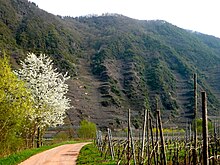Calmont (hill)
| Calmont | |
|---|---|
Deutschland )
| |
| Features | Gallo-Roman procession temple on the Calmont,, Vineyards: Bremmer Calmont and Ellerer Calmont,, Viewing plateau at the Monument to the Wartime Generation,, Calmont Trail, and Paragliding launch pad |



The Calmont, also called the Calmond, between
Name
The name Calmont may be derived either:
- from the Latin calidus = "warm" and mons = "hill", i.e. "warm hill",
- from the Celtic kal = "hard", i.e. "rock hill"
Geography
Location
The Calmont rises between Bremm to the south-southwest and Ediger-Eller further downstream to the southeast, both of which lie on the left bank of the river. Its summit is on the municipal boundary; its southern hillside belongs to Bremm, its northern and eastern slopes to Ediger-Eller. The |Ellerbach stream flows to the north and east around the ridge and empties into the Moselle southeast of the hill. To the southwest the countryside climbs up to the Schafstall (423.0 m).
Natural region allocation
The Calmont belongs within the
Height
The 380.6 m-high Calmont summit lies 293.1 metres above the Moselle, on which the lowest contour line on topographic maps is 87.5 m.[1] It is also an average of about 270 metres above Bremm. Around 215 metres east-northeast of the summit is a spot height of 378.4 m.[1]
Conservation
The Calmont lie within the protected area of Moselle Region from Schweich to Koblenz (Moselgebiet von Schweich bis Koblenz, CDDA No. 323051; established in 1979; 1187.48 km2), in the Special Area of Conservation of Hillsides and Side Valleys of the Lower Moselle (Moselhänge und Nebentäler der unteren Mosel, FFH No. 5809-301; 162.73 km2) and in the bird reserve of Woods between Wittlich and Cochem (Wälder zwischen Wittlich und Cochem, VSG No. 5908-401; 235.52 km2). Neither the SAC nor the bird reserve quite reach the banks of the Moselle river.[3]
Gallo-Roman Ambulatory Temple
On the summit of the Calmont there was a Roman hill shrine from the 2nd to around the 4th century AD. In 2005 the first archaeological excavations took place; they continued in 2008. In connexion with the excavations this Gallo-Roman ambulatory temple was reconstructed[4] and opened on 16 May 2009[5]
Viniculture
In the late 20th century only part of the original
Monument and viewing plateau
665 metres (
Transport and Hiking
Along the southern foot of the Calmont, running from west to east between the Moselle villages of
On the Calmont runs the Calmont
Paragliding
Near the Monument to the Wartime Generation is a launch area for paragliders who can fly over the Moselle valley in suitable wind conditions. The Calmont massif is like a huge concave mirror in the Moselle valley and, with its southerly orientation and slate bedrock, offers ideal conditions for the creation of thermal upcurrents.
References
- ^ a b c d e Map service of the Landscape Information System of the Rhineland-Palatinate Nature Conservation Office (Naturschutzverwaltung Rheinland-Pfalz)
- ^ Landentwicklung und Ländliche Bodenordnung, Ministerium für Umwelt, Landwirtschaft, Ernährung, Weinbau und Forsten des Landes Rheinland-Pfalz, Nachrichtenblatt, Heft 53/2012, S. 12, auf rlp.de (PDF; 10,4 MB)
- Federal Agency for Nature Conservation
- ^ Der Gallo-römische Umgangstempel auf dem Calmont, Förderverein Calmont-Region e. V., retrieved, 4 January 2014, auf calmont-region.de
- ^ Einweihung des gallorömischen Höhenheiligtums auf dem Calmont in: Das gallorömische Bergheiligtum auf dem Calmont → Einweihung des Bergheiligtums am 16. Mai 2009, retrieved, 4 January 2014, auf calmont-klettersteig.com
- ^ Karte der Weinlage Bremmer Calmont, auf weinlagen-info.de
- ^ a b Der Bremmer Calmont: Der Calmont-Klettersteig und Die Eröffnungsfeier am 4. Mai 2002, retrieved, 4 January 2014, auf calmont-klettersteig.com
- ^ Botanische Exkursion an die Mosel 13.08.2009–16.08.2009, retrieved 1 September 2015, auf botanik-bochum.de
External links
- Information about the Calmont, at calmont.info
- Der Bremmer Calmont, at bremmer-calmont.de
